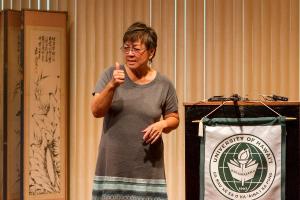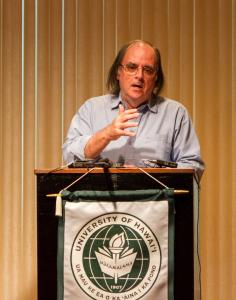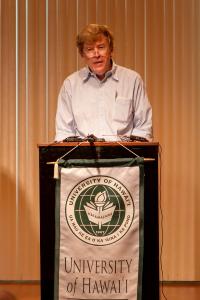Research team discovers existence of Hawai'i Sign Language
University of Hawaiʻi at MānoaThe announcement was made in conjunction with the 3rd International Conference on Language Documentation and Conservation being held at UH Mānoa from February 28-March 3. On Sunday, March 3, from 10:20-10:50 a.m. the research team will present its research, History and documentation of old Hawai‘i sign language and deaf lives in the past, in the Pacific Room located on the second floor in the Imin International Conference Center on the UH Mānoa campus.
HSL, the indigenous language of Deaf people in Hawai‘i, is one of only two known surviving sign languages in the United States. The other is American Sign Language, or ASL, which is widely used by the deaf community in the U.S.
ASL started to be used in Hawai‘i in the 1940s and became dominant by the 1950s, gradually superimposing itself on the indigenous Hawai‘i Sign Language that predated it. However, some of the old sign language is remembered by elderly Deaf people in Hawai‘i. One of the champions of HSL is Kapi‘olani Community College ASL instructor Linda Lambrecht. She has long been an advocate for its proper documentation. HSL was, of course, known to its users, and occasional mention of it may be found in various places, including the internet. But there had never been an attempt to document it or to determine whether it is a separate language, a dialect of ASL, or simply an improvised pidgin.
In 2010, Lambrecht and her former student, Barbara Earth, who is currently a Research Fellow in the Department of American Sign Language and Deaf Studies at Gallaudet University, approached UH Mānoa’s Department of Linguistics, one of the world’s leading centers for language documentation and conservation, for assistance and advice. A grant from the Hawai‘i Council for the Humanities under the direction of UH Mānoa Linguistics Professor William O’Grady, and financial assistance from various other sources, enabled a team led by Lambrecht and Earth to locate and interview 19 elderly Deaf people and two adult children of Deaf parents (CODAs) on four of the Hawaiian islands.
Analysis of the video records of those interviews, with the assistance of Dr. James Woodward, Adjunct Professor in the Department of Linguistics at UH Mānoa and Co-Director of the Center for Sign Linguistics and Deaf Studies at the Chinese University of Hong Kong, has identified a substantial set of vocabulary items and grammatical features of HSL. These findings have allowed the research team to confirm the uniqueness of HSL and to conclude that it is, in fact, a previously undocumented language. This marks the first time since the 1930s that a previously unknown language, either spoken or signed, has been documented in the United States. HSL may well be the last of America’s undiscovered languages.
Like spoken languages, sign languages have their own full-fledged vocabulary and grammar. They evolve in a community of users, and are not signed versions of spoken languages. As emphasized by the Linguistic Society of America, sign languages offer the same rich opportunities for expression and communication that spoken languages do, but use a different sensory modality.
The full history of HSL is yet to be told, but the language is likely to have originated among the Deaf population in Hawai‘i by the late 1800s. The founding of a school for the Deaf in Honolulu in 1914 provided a setting in which children could learn and carry on the language on their own, even though the school itself had an “oralist” philosophy that opposed the teaching and use of sign language.
The Deaf community had a hero in Edwin Inn, a Chinese-Hawaiian Deaf man who attended the Territorial School for the Deaf and the Blind in the 1920s and early 1930s, and later taught HSL to young Deaf adults as Instructor and President of a Deaf Club in 1939-1940.
The Research Team
Linda Lambrecht, American Sign Language instructor at Kapi‘olani Community College. As a child, she learned Hawai‘i Sign Language and her recollections of it ultimately led to its rediscovery and documentation. Together with Barbara Earth, she led the research team that located and identified elderly users of HSL.
Barbara Earth, PhD, Adjunct Assistant Professor, Department of Linguistics, UH Mānoa and Research Fellow, Department of American Sign Language and Deaf Studies, Gallaudet University. Together with Linda Lambrecht, she is primarily responsible for documenting the existence of Hawai‘i Sign Language.
James Woodward, PhD, Co-Director of the Centre for Sign Linguistics and Deaf Studies, Chinese University of Hong Kong and Adjunct Professor of Linguistics at UH Mānoa. He is renowned for his work on previously unstudied sign languages of Asia and the Pacific; he helped confirm the uniqueness of HSL and its status as an independent language. He will play a key role in the next step in researching Hawai‘i Sign Language.
William O’Grady, PhD, Professor, Department of Linguistics at UH Mānoa. He was the recipient of a grant (co-authored with Barbara Earth) from the Hawai‘i Council for the Humanities that helped support fieldwork on O‘ahu and on the neighbor islands. He served as on-campus coordinator for the project, and chaired the press conference that announced the group’s findings.
Other members of the research team
Rebecca Siu, MA Linguistics, Chinese University of Hong Kong and MA, ASL and Deaf Studies, Gallaudet University. She played a major role in the fieldwork and technical aspects of filming and editing.
Ākeamakamae Kiyuna, MA (UHM linguistics), currently an instructor at the University of Hawai‘i at Hilo. She participated in the fieldwork, served as a liaison to the Hawaiian community, and researched references to Deaf people in Hawaiian-language newspapers.
Ben Bahan, PhD, Professor, Department of ASL and Deaf Studies, Gallaudet University. He participated in the fieldwork conducted on Molokai and served as advisor to the research team.
Research on Hawai‘i Sign Language has been made possible by the generous financial support of the following organizations:
The Hawai‘i Council for the Humanities
Gallaudet University
The Gallaudet University Regional Center for the Pacific
The College of Languages, Linguistics and Literature (UH Mānoa)
The Department of Linguistics (UH Mānoa)
Hawai‘i School for the Deaf and the Blind (HSBD)
Aloha State Association of the Deaf (ASAD)
Patty Sakal




